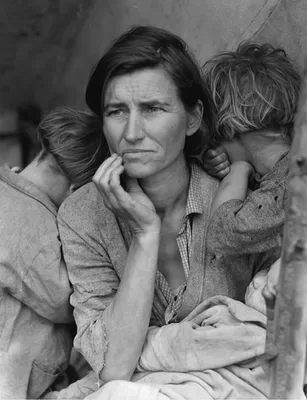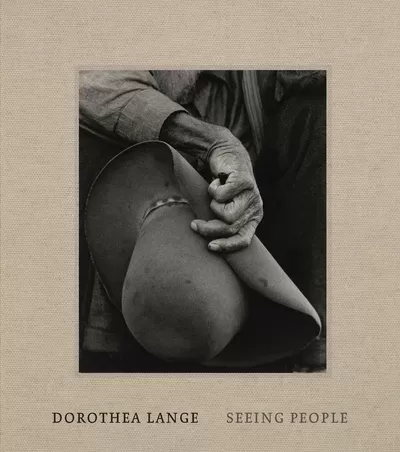Dorothea Lange’s profound impact on documentary photography and portraiture is indisputable, as her work transcended the confines of mere images to become a vehicle for social change and awareness.
Her sensitive and compassionate approach to her subjects, often marginalized or disenfranchised, humanized their stories and struggles, making them relatable to a broad audience.
Lange’s photography bridged the gap between art and social advocacy, capturing the essence of people’s lives, core values, and sense of self, while simultaneously highlighting pressing social issues.
Her enduring legacy lies in her ability to evoke empathy and understanding through the lens, solidifying her position as a trailblazer in the world of documentary photography and portraiture, reshaping our perception of the medium and its power to shed light on the human condition.
The Dorothea Lange story
In 1918, Dorothea Lange embarked on her professional journey as a commercial studio photographer in San Francisco. Her studio quickly evolved into a hub for artists engaged in profound dialogues on the realms of photography and art.
Two years later, in 1920, she wed Maynard Dixon, a renowned painter known for his depictions of western subjects. Dixon’s influence was pivotal as he inspired Lange to step out of the studio and explore the world through her lens.
She joined him on sojourns across the American Southwest, capturing the essence of rural landscapes, Dixon in his creative element, and the Indigenous communities he was dedicated to portraying.
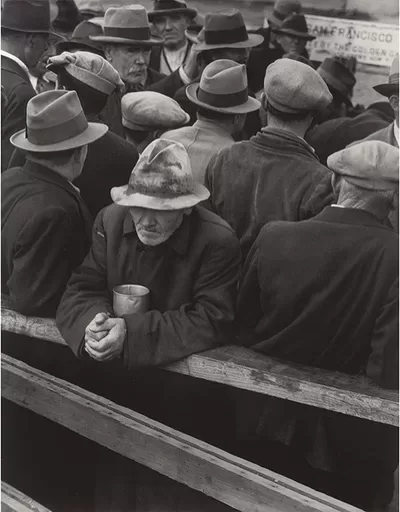

In 1933, Dorothea Lange shifted her focus to the bustling streets of San Francisco.
During this period, she captured poignant images like “White Angel Breadline, San Francisco, California (1933),” which poignantly conveyed the stark consequences of the Great Depression and the hardships endured by the city’s disenfranchised men and women.
Dorothea Lange White Angel Breadline, San Francisco, California, 1933
Lange also turned her lens to labor organizers and demonstrators at May Day events in San Francisco’s Civic Center Plaza.
Her photographs honed in on the activists who were speaking, listening, or holding signs, and she committed to producing prints within a mere 24 hours, as exemplified by “May Day, San Francisco, California (1934).”
She also documented the subsequent strikes, creating portraits of impassioned speakers and demonstrators brandishing placards, all while capturing the police presence in works such as “Street Demonstration, San Francisco (1934).”
It was in 1934 that Lange crossed paths with the labor economist Paul Schuster Taylor. This encounter marked the beginning of her documentation of the challenges faced by migrant farmers who had journeyed to California from the South and Midwest in search of new opportunities for their livelihoods.
Between 1935 and 1943, Dorothea Lange dedicated herself to a series of impactful assignments, serving the US Resettlement Administration, Farm Security Administration, and War Relocation Authority.
Throughout this period, her lens was firmly fixed on capturing the resilience of families enduring the harsh realities of the Great Depression, farm laborers, rural cooperative communities, migrant camps, and the forced internment of Japanese Americans during the early stages of World War II.
The resulting images served as a poignant testament to the profound human and economic toll experienced across the United States, stemming from issues like farm tenancy, racism, the enduring legacy of slavery, the changing climate, and the mass migrations of the era.
These portraits, occasionally accompanied by insightful interviews, introduced a deeply personal dimension to Lange’s stark depictions of makeshift housing and agricultural landscapes, solidifying her distinctive documentary style.
Dorothea Lange’s Migrant Mother
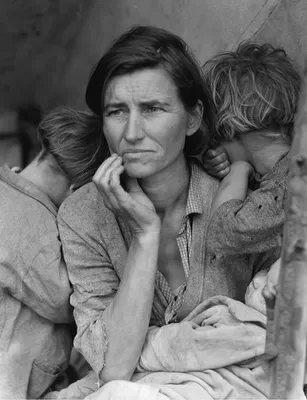

Dorothea Lange’s famous portrait shows Florence Thompson with several of her children in a photograph known as “Migrant Mother”.
The Library of Congress caption reads: “Destitute pea pickers in California. Mother of seven children. Age thirty-two. Nipomo, California.”
Lange took this photograph with a Graflex camera on large format (4″x5″) negative film in 1936.
In May 2023, Sotheby’s New York auctioned pieces from the Pier 24 Photography’s oversized 1940s-era print of Migrant Mother for double estimate $609,000
During World War II, Dorothea Lange embarked on one of her most compelling photographic series, commissioned by the War Relocation Authority.
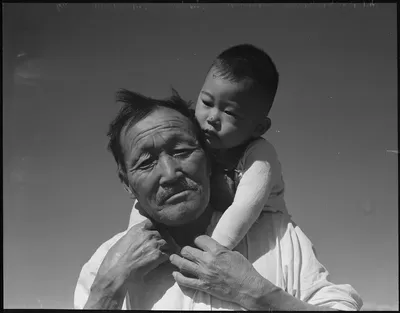

Her work revolved around capturing the forced internment of Japanese Americans in California’s Manzanar, as evident in pieces like “Grandfather and Grandson of Japanese Ancestry at a War Relocation Authority Center, Manzanar, California (July 1942).”
Simultaneously, she documented the shifting dynamics within California’s social landscape. The state’s burgeoning economy, largely driven by the expansion of defense industries, brought about significant changes.
This included the migration of African Americans from the South and women entering previously male-dominated and segregated industries such as shipbuilding.
Moving into the 1950s, Lange continued her pursuit of stories centered on people and their communities, both for personal projects and publications like Life magazine. Her work expanded to encompass her initial forays into Europe, Asia, South America, and North Africa, demonstrating her global reach as a photographer.
Dorothea Lange: Seeing People, Hardcover, 2023 by Philip Brookman, Sarah Greenough, Andrea Nelson, Laura Wexler, Nana Adwoa Nyamekye Ferdnance Elizabeth Fortune Kyra March
Exploring Dorothea Lange’s Pioneering Approach to Portraiture: National Gallery of Art Exhibition
Dorothea Lange, the renowned American photographer (1895–1965), left an indelible mark on the 20th-century photography landscape with her extensive and innovative career.
“Dorothea Lange: Seeing People” delves into her lifelong exploration of how portrait photography can encapsulate the humanity of her subjects.
This exhibition showcases how her photographs played a pivotal role in shaping modern documentary photography by connecting ordinary individuals to historical moments, spanning from the Great Depression to the mid-1960s, resonating with us in the 21st century.
With a collection of 101 photographs, the exhibit highlights Lange’s inventive techniques in capturing individuals and underscores her work in addressing pressing social issues such as economic inequality, migration, poverty, and racism.
You can experience this extraordinary exhibition from November 5, 2023, through March 31, 2024, at the West Building of the National Gallery of Art, Washington, DC
Dorothea Lange: Seeing People, Hardcover, 2023 by Philip Brookman, Sarah Greenough, Andrea Nelson, Laura Wexler, Nana Adwoa Nyamekye Ferdnance Elizabeth Fortune Kyra March
“Dorothea Lange: Seeing People” delves into the profound impact of Lange’s portraits on shaping our contemporary understanding of documentary photography, illuminating their significance in her creative practice.
This comprehensive exhibition is organized into six thematic sections, offering a remarkable collection of portraits. These span from her early days as a San Francisco studio photographer, with her earliest work dating back to 1919, to her poignant documentation of the Great Depression and her emotive portrayal of ordinary individuals and communities during the 1950s and early 1960s.
The exhibited works encompass a diverse range of subjects, including portraits of Indigenous people in Arizona and New Mexico from the 1920s and early 1930s, the striking laborers, migrant farmworkers, and rural African Americans during the Jim Crow era.
Lange’s lens also captured the injustices faced by Japanese Americans denied their civil rights during World War II and the vibrant postwar baby boomers.
Additionally, her global perspective is highlighted with portraits of people from Ireland, Korea, Vietnam, Egypt, and Venezuela, taken in the decade preceding her passing in 1965.
Further reading
Dorothea Lange: Seeing People, Hardcover, 2023 by Philip Brookman, Sarah Greenough, Andrea Nelson, Laura Wexler, Nana Adwoa Nyamekye Ferdnance Elizabeth Fortune Kyra March
Presented by the National Gallery of Art and distributed in collaboration with Yale University Press, this 208-page illustrated book delves into Dorothea Lange’s extensive exploration spanning decades.
It examines how photography, as a means of expressing people’s fundamental values and self-identity, played a pivotal role in broadening our contemporary comprehension of portraiture and the essence of documentary practice.
Lange’s compassionate and insightful portraits, often featuring marginalized individuals, played a transformative role in enhancing public awareness of significant social issues throughout the 20th century.
See books featuring Dorothea Lange on Amazon
Disclaimer: We may earn a small commission from sales at Amazon
Related stories
Photography: Real & Imagined at National Gallery of Victoria
Can a documentary photograph change the world?
Gregory Halpern “somewhere between the documentary and fine art”

